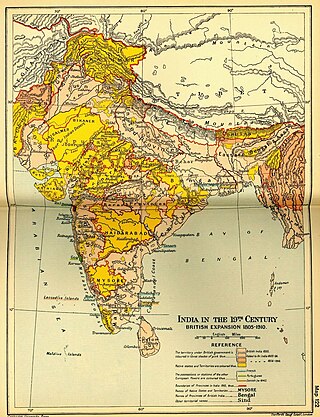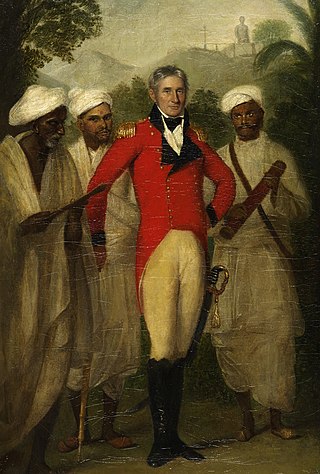
Ghanshyam Das Birla was an Indian businessman and member of the Birla Family.

Company rule in India was the rule of the British East India Company on the Indian subcontinent. This is variously taken to have commenced in 1757, after the Battle of Plassey, when the Nawab of Bengal Siraj ud-Daulah was defeated and replaced with Mir Jafar, who had the support of the East India Company; or in 1765, when the Company was granted the diwani, or the right to collect revenue, in Bengal and Bihar; or in 1773, when the Company abolished local rule (Nizamat) in Bengal and established a capital in Calcutta, appointed its first Governor-General, Warren Hastings, and became directly involved in governance. The Company ruled until 1858, when, after the Indian Rebellion of 1857 and the Government of India Act 1858, the India Office of the British government assumed the task of directly administering India in the new British Raj.

Scottish Church College is a college affiliated by Calcutta University, India. It offers selective co-educational undergraduate and postgraduate studies and is the oldest continuously running Christian liberal arts and sciences college in Asia. It has been rated (A) by the Indian National Assessment and Accreditation Council. Students and alumni call themselves "Caledonians" in the name of the college festival, "Caledonia".

Alexander Duff, was a Christian missionary in India; where he played a large part in the development of higher education. He was a Moderator of the General Assembly and convener of the foreign missions committee of the Free Church of Scotland and a scientific liberal reformer of anglicized evangelism across the Empire. He was the first overseas missionary of the Church of Scotland to India. On 13 July 1830 he founded the General Assembly's Institution in Calcutta, now known as the Scottish Church College. He also played a part in establishing the University of Calcutta. He was twice Moderator of the Free Church of Scotland in 1851 and 1873, the only person to serve the role twice.

Colonel Colin Mackenzie was Scottish army officer in the British East India Company who later became the first Surveyor General of India. He was a collector of antiquities and an orientalist. He surveyed southern India, making use of local interpreters and scholars to study religion, oral histories, inscriptions and other evidence, initially out of personal interest, and later as a surveyor. He was ordered to survey the Mysore region shortly after the British victory over Tipu Sultan in 1799 and produced the first maps of the region along with illustrations of the landscape and notes on archaeological landmarks. His collections consisting of thousands of manuscripts, inscriptions, translations, coins and paintings, which were acquired after his death by the India Office Library and are an important source for the study of Indian history. He was awarded a Companion of the Order of the Bath on 4 June 1815.

The Bengal Presidency, officially the Presidency of Fort William in Bengal and later Bengal Province, was a province of British India and the largest of all the three Presidencies. At the height of its territorial jurisdiction, it covered large parts of what is now South Asia and Southeast Asia. Bengal proper covered the ethno-linguistic region of Bengal. Calcutta, the city which grew around Fort William, was the capital of the Bengal Presidency. For many years, the Governor of Bengal was concurrently the Governor-General of India and Calcutta was the capital of India until 1911.

The former communities of Jewish migrants and their descendants from Baghdad and elsewhere in the Middle East are traditionally called Baghdadi Jews or Iraqi Jews. They settled primarily in the ports and along the trade routes around the Indian Ocean and the South China Sea.

The Calcutta Boys' School is an independent private day school located in Kolkata (Calcutta), West Bengal. was founded by the Rev. James Mills Thoburn, and was opened in 1877. It was endowed by Robert Laidlaw and others interested in the education of the sons of the Anglo-Indian and domiciled European community.
Education in West Bengal is provided by both the public sector as well as the private sector. The modern education system was developed by the British missionaries and the Indian social reformists. West Bengal has many institutes of higher education like –Indian Institute of Technology Kharagpur, Marine Engineering and Research Institute, Jadavpur University, Indian Institute of Management Calcutta, Indian Institute of Engineering Science and Technology, Shibpur, Indian Institute of Science Education and Research, Kolkata, National Institute of Technology, Durgapur, Indian Institute of Information Technology, Kalyani, Indian Statistical Institute, West Bengal University of Health Sciences, University of North Bengal and University of Calcutta.
Bhowanipore is a neighbourhood of South Kolkata in Kolkata district of West Bengal, India.

Hare School is one of the oldest schools in Kolkata, India, teaching grades one to twelve under the West Bengal Board of Secondary Education and the West Bengal Council of Higher Secondary Education. It is a state government-administered boys school and was established by the Scottish watch-maker, David Hare. The establishment date is not agreed upon, but the official year of establishment is 1818. Thus the school is declared as the oldest western type school in Asia. The school is situated opposite the Presidency University, and is also adjacent to the University of Calcutta and Hindu School. The combined campuses of the Hare School and Presidency College is one of the largest in Kolkata.
Calcutta and Burmah Steam Navigation Company (C&BSN) was formed in 1856 and was the immediate forerunner of British India Steam Navigation Company (BISN). The company was formed out of Mackinnon, Mackenzie & Co, a trading partnership of the Scots William Mackinnon and Robert Mackenzie, who had set up their business in Calcutta, India.

John Borthwick Gilchrist was a Scottish surgeon, linguist, philologist and Indologist. Born and educated in Edinburgh, he spent most of his early career in India, where he made a study of the local languages. In later life, he returned to Britain and lived in Edinburgh and London. In his final years, he moved to Paris, where he died at the age of 81.

The Regulating Act 1773 was an Act of the Parliament of Great Britain intended to overhaul the management of the East India Company's rule in India. The Act did not prove to be a long-term solution to concerns over the company's affairs. Pitt's India Act was therefore subsequently enacted in 1784 as a more radical reform. It marked the first step towards parliamentary control over the company and centralised administration in India.

Christianity in West Bengal, India, is a minority religion. According to the 2011 census of India, there were 658,618 Christians in West Bengal, or 0.72% of the population. Although Mother Teresa worked in Kolkata (Calcutta), Christianity is a minority religion in Kolkata as well. West Bengal has the highest number of Bengali Christians. Bengali Christians have been established since the 16th century with the advent of the Portuguese in Bengal. Later in the 19th and 20th centuries, many upper-class Bengalis converted to Christianity during the Bengali Renaissance under British rule, including Krishna Mohan Banerjee, Michael Madhusudan Dutt, Anil Kumar Gain, and Gnanendramohan Tagore. Aurobindo Nath Mukherjee was the first Indian to be Anglican Bishop of Calcutta.

The Scottish Cemetery at Calcutta was established in 1820 catering to the specific needs of the large Scottish population in the Kolkata area. These Scots, including soldiers, missionaries, jute traders and businessmen, were attached to numerous enterprises in the area such as the headquarters of the East India Company, and the administration of the British India, whose capital was here. The cemetery was utilised until the 1940s but was abandoned in the 1950s and neglected following India's independence. Well over 90% of those buried bear recognisably Scots names such as Anderson, McGregor, Campbell and Ross. Around 10% are Bengali.
John Anderson Graham was a Scottish minister and the first missionary from Young Men's Guild sent to North Eastern Himalayan region Kalimpong—then in British Sikkim, currently in West Bengal.
Andrew Yule was a businessman who founded Andrew Yule and Co.
Jardine, Skinner and Company was a trading company based in Calcutta, India. It was founded in 1825, initially dealing in textiles. Later it branched out into opium, tea, timber and petroleum. The company was closely associated with Matheson & Company of London and Jardine Matheson & Co. of Hong Kong.
John Murray Mitchell was a Scottish missionary and orientalist who worked in his country of birth, India and France.













